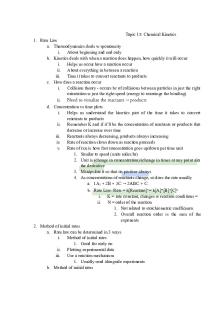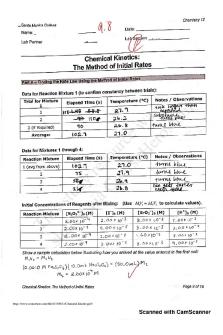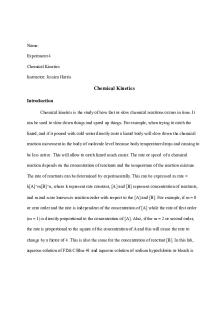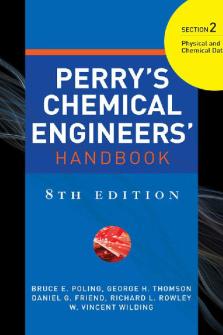Problems Heterogeneous Catalysis For Chemical Engineers - Kinetics PDF

| Title | Problems Heterogeneous Catalysis For Chemical Engineers - Kinetics |
|---|---|
| Course | Heterogeneous Catalysis for Chemical Engineers |
| Institution | Technische Universiteit Delft |
| Pages | 11 |
| File Size | 354.6 KB |
| File Type | |
| Total Views | 87 |
Summary
Problems Heterogeneous Catalysis for Chemical Engineers Chemical kinetics of catalytic reactions 1. The dehydrogenation of ethanol into hydrogen and ethanal over a catalyst (Frankaerts and Froment) resulted in the following sequence of elementary steps: 1. 2. 3. 4. C2H5OH C2H4O H2 The second step is...
Description
Problems Heterogeneous Catalysis for Chemical Engineers Chemical kinetics of catalytic reactions 1. The dehydrogenation of ethanol into hydrogen and ethanal over a copper-cobalt catalyst (Frankaerts and Froment) resulted in the following sequence of elementary steps: 1. 2. 3. 4.
C2H5OH + * C2H5OH* + * C2H4O* H 2*
C2H5OH* C2H4O* + H2* C2H4O + * H2 + *
The second step is rate determining, the other steps are in quasi equilibrium. Derive a rate expression for this reaction
2. Nitrous oxide has been identified as an important contributor to the ozone destruction in the stratosphere and as a greenhouse gas. At present much effort is put in the development of active catalysts and processes to reduce man-made emissions of N2O The decomposition of nitrous oxide over transition metal ion-exchanged ZSM-5 (Co, Fe and Cu) has been found to be first order in the N2O partial pressure and is not inhibited by oxygen. 2 N 2O 2 N 2 + O 2
(1)
(a) Propose a two-step kinetic model, where N2O reacts from the gas phase in both irreversible steps, that can account for these observations and (b) Derive a rate expression with both steps rate determining By addition of CO the rate of N2O destruction is increased moderately for Co-, tremendously for Fe-, while that for Cu-ZSM-5 passes through a maximum as a function of the CO/N2O molecular ratio, see the figure below.
1.0
X(N2O)
0.8
Cu-ZSM-5
0.6
Fe-ZSM-5 0.4
0.2
0.0 0.0
Co-ZSM-5 0.5
1.0
1.5
2.0
molar CO/N 2O ratio
(c) Give an interpretation of these results in terms of surface occupancies and indicate the ratio k1/k2. Estimate the fraction of oxidised sites at CO/N2O = 0 for all catalysts. (d) Explain the observed maximum for Cu-ZSM-5.
The following activation energies are found for the catalysts at CO/N2O = 0 and 2. Apparent activation energies (kJ/mol) only N2O
CO/N2O=2
Co
110
115
Cu
138
187
Fe
165
78
(e) What do these values represent globally?
3. Sinfelt, Hurwitz and Shulman found for the dehydrogenation of methylcyclohexane to toluene that the following global scheme could represent their rate data. 1. A + * 2. A* 3. R*
A* R* + 2H2 T + H2 + *
(a) Derive a rate expression for this reaction scheme. (b) What are the pressure dependencies for the reactants and products? (c) Is the proposed scheme in agreement with the observation that toluene does not affect the reaction rate, not did benzene?
4. Hosten and Froment studied the isomerization of n-pentane to i-pentane in the presence of hydrogen over a bifunctional Pt-Al2O3 catalyst. Globally first a dehydrogenation takes place over the metallic function, followed by an isomerization over the acidic alumina sites and finally a hydrogenation of the i-pentene takes place over Pt. The reaction sequences can be given as: Dehydrogenation (e) A + * A* (f) A* + * M* + H2* (g) H2* H2 + * (h) M* M+* Isomerization (i) M + # M# (j) M# N# (k) N# N+# Hydrogenation (l) N + * N* (m) H2 + * H 2* (n) N* + H2* B* + * (o) B* B+* (e) Derive a rate expression for this reaction where step 6. is rate determining. (f) The overall reaction rate is found pressure independent. Is that in agreement with your result?
5. The gas phase reaction A + B C is catalysed by a solid catalyst. Sketch the dependency of the initial reaction rate and total pressure for the following situations, using an equimolar feed mixture of A and B: 1. A and B adsorb first at the active sites and react in the adsorbed state in a rate determining step. 2. The adsorption of A is rate determining. Molecules react in the adsorbed state. 3. Same kinetic model as above, but now desorption of C is rate determining 4. A so-called Rideal-Eley model is applicable: adsorbed A reacts with B from the gas phase to adsorbed C in a rate determining step.
6. 13 12 13 12 For the oxygen exchange reaction CO2 CO CO CO2 over a potassium on carbon catalyst the following rate expression has been found:
r
A pCO 2 p 1 B co 2 pCO
Propose a simple kinetic model that satisfies this relation.
7. For the ammonia synthesis the following kinetic model has been found: 1. 2. 3. 4. 5. 6.
N2 + 2* H2 + 2* N* + H* NH*+ H* NH2*+ H*
2 N*
In this model the first step is rate determining, the other steps may be assumed to be in quasiequilibrium under practical conditions. Apparently the formation of N* species is difficult. The catalyst surface, however, appear to be occupied for more than 99.9% with N*. Can you explain this?
8. In the dehydrogenation of secundair-butyl alcohol over a supported copper catalyst methylethylketone is formed: CH3CHOHC2H5 CH3COC2H5 + H2 Experimentally it has been observed that two different reaction steps are rate determining, depending on the reaction temperature. At low temperature the surface reaction seems to be rate determining, while at high temperature the desorption of hydrogen seems rate determining. A selection of the initial rate data is given in the table. 1. Propose a three step kinetic model for this reaction 2. Derive an initial reaction rate expression for the two cases 3. Calculate the rate parameters in the r0 expression at 371 and 288oC
Table T (oC) 371
pAlcohol (bar) 1.0 2.0 4.0 9.0 12.0
r0 (mol/h.gcat) 0.195 0.189 0.188 0.198 0.190
315.5
1.0 4.0 7.0 10 14.6 5.5 8.5 3.0 0.22 1.0
0.0392 0.0416 0.0416 0.0326 0.0247 0.0415 0.0376 0.0420 0.0295 0.0410
302
1.0 3.0 5.0 7.0 9.6
0.0227 0.0277 0.0255 0.0217 0.0183
288
1.0 3.0 2.0
0.0115 0.0161 0.0146
9. For the catalytic decomposition of alcohols into alkenes and water the following results have been obtained: Alcohol n-propanol iso-propanol n-butanol-1
High pressure 172 163 184
Ea (kJ/mol) Low pressure 119 109 117
Difference 53 54 67
Under all conditions water is adsorbed much stronger at the catalyst than the other two components. The apparent (observed) activation energy, obtained from an Arrhenius-plot of ln(r) versus 1/T , is significantly different for high and low pressure conditions. The backward reaction is negligible in all cases and a single-site kinetic model can be assumed for this reaction. 1. Demonstrate by means of a kinetic analysis what the physical meaning of the constant difference of about 58 kJ/mol is. 2. Is it logical that this difference is about the same for all three alcohols?
10. At room temperature sucrose can be hydrolysed under influence of the enzym sucrase. (a) Demonstrate that this biocatalyzed reaction can be described by a rate expression of the Michaelis-Menten form:
r
k 3c Sc E 0 cS M
with M the Michaelis constant
(b) What does this constant M represent? (c) Can you determine k3 ? If yes, how? What is the difference with heterogeneous catalysis?
11. Several LHHW types of rate expressions can be distinguished. These expressions include forms like:
r
kKp 1 Kp
r
kKp 2 1 Kp
r
kKp2 2
1 Kp
r
kKp
1 Kp 2
The apparent reaction order varies differently for these expressions. Derive expressions for the apparent reaction order n for these four types of rate expressions and sketch the behaviour of n as a function of Kp.
Problems Heterogeneous Catalysis for Chemical Engineers Catalyst effectiveness and testing 1. a. b.
How can you determine if external mass transfer is rate limiting? Give as many possible ways to do so and explain why for each way. The true reaction order and activation energy are n and Ea,respectively. How large are the observed reaction order and activation energy if external mass transfer are rate limiting?
2. a. External mass transfer limitations can be verified by the Carberry number, Ca. 1. How would you calculate Ca 2. What are the limiting values of Ca, and why? 3. Give the physical interpretation of Ca b. Pore diffusion limitations in porous catalysts can be verified by the Thiele modulus . 1. Give for a first order irreversible reaction and dimensions of the parameters 2 2. What is the physical meaning of ? 3. Give the relation between the catalysts effectiveness and for the limits of approaching 1 and approaching 0. 4. To be able to calculatate the kinetics of the reaction has to be known. If the kinetics are unknown give two ways to be able to check the presence or absence of pore diffusion limitations. 5. What is the effect on the observed reaction rate if one increases the dispersion of the active phase of a catalyst by a factor of two, while one operates in a strongly pore diffusion controlled regime? Motivate your answer. 3. a.
b. c. d.
4. a. b. c.
In the stationary state operation of a catalyst particle the mass transport of reactants through the film layer surrounding the particle equals the conversion rate inside the particle. Give the energy balance over the film layer. Derive an expression for the temperature at the external surface of the catalyst in terms of dimensionless parameters. Name them and give their physical interpretation. Which criteria can be used to verify if external mass and heat transport limitations are present? Also the heat effect of a reaction inside a catalyst particle is expressed by a parameter. Give name and expression. What is its physical interpretation?
What is the definition of the catalyst effectiveness factor? Which parameter determines the isothermal internal effectiveness factor? What is its physical interpretation ? Some generalizations have been made for the catalyst effectiveness. Wich ones and why ?
5. Show that for a porous catalyst particle and an nth-order reaction the following expression is valid for the effectiveness factor:
i
Vp
n1 2
Ap c s
2 G
dc dx x L
6. a.
Derive the expression of the catalyst effectiveness for a first order isothermal irreversible reaction, given the concentration profile for a reactant in a slab:
x cosh L c cs cosh b. c.
7. a.
Give expressions for for the limits of no diffusion limitations and strong diffusion limitations. What will be the observed reaction order, the observed activation energy and dependency on the slab thickness L in the case of strong diffusion limitations ?
c.
External and internal heat and mass transport take place during operation of catalyst particles. Mention the dimensionless groups that determine the overal performance of the catalyst. Which gradients are generally large (important) and which not. Give an order of these gradients and sketch a cross section of a catalyst particle with the temperature and concentration profiles for an exothermal reaction. How can the catalyst particle be described best in a simplified way ?
8. a.
Given a solid phase density of a catalyst b = 3.8 g/cm3, a particle density p = 1.5 g/cm3
b.
and a specific surface area S = 200 m2/g, calculate the catalyst’ pore volume Vp, the particle porosity p and the average pore radius r0 (use SI units m, kg ) b.
A reaction rate is rv is expressed per unit catalyst volume. A catalyst bed porosity equals b . Give an expression for rV, rw and rS, the reaction rates per unit bed volume, catalyst weight and specific catalyst surface area, respectively.
9. For a first order catalysed gas-phase decomposition reaction under chemically controlled conditions the following data have been reported: -1 rv = 10-6 mol s-1 (cm3cat) -5 -3 cA = 10 mol cm @ 1 bar, 673 K De = 10-7 m2 s-1 Which maximum particle diameter of a spherical catalyst may still be used without diffusional disguise?
10. A conversion rate of 8 mol s-1 is being observed for the isothermal gas phase decomposition of a component A in a catalyst bed of 0.5 m3 with a porosity b =0.4 at 600 K and at pA = 1 bar. The spherical catalyst particles have a diameter of 15 mm. In this case De = 2·10-6 m2 s-1. Are diffusion limitations present ? Motivate your answer. Use the correct units.
11. Cylindrical alumina extrudates (5×5 mm) with highly dispersed Pt are used for the dehydrogenation of cyclohexane to toluene. Each particle weighs 150 mg, the solid phase density b = 2.5 g/cm3, the BET surface area 150 m2 g-1 and the tortuosity = 1.4. At 700 K the intrinsic rate constant amounts to kv = 4 s-1 (What is the reaction order?). a. What will be the observed reaction rate constant at this temperature if: - Knudsen type diffusion dominates - Molecular diffusion of cyclohexane in hydrogen dominates b. Which factors determine whether Knudsen or molecular diffusion dominate ? c. If DK = 5·10-6 m2 s-1 and Dm = 7·10-6 m2 s-1 calculate De. 12. One has three types of catalysts particles at hand: spherical, cylindrical and slab-like (pure alumina monolith). It is given that the diameter of the spheres and cylinders are 2L, like the slab thickness. Determine the order of catalyst effectiveness for these shapes for an nth-order irreversible isothermal reaction, given equal catalyst particle volumes Vp. Neglect the end effects for cylinder and slab.
13. Strong diffusion limitations occur during an isothermal irreversible second order reaction. a. What is the expression for the Thiele modulus in this case ? b. What is the observed reactant pressure dependency in this case if: - Knudsen diffusion dominates - Molecular diffusion dominates for pure reactant - Molecular diffusion dominates for a highly diluted reactant at constant total pressure.
14. a. Set up a mass balance for thin layer in a porous catalyst slab in which diffusion and a first order irreversible reaction take place under isothermal conditions. Slab thickness = 2L. b. Derive the differential equation, make it dimensionless and give the corresponding boundary conditions. * * c. Solve the ODE, assuming a solution of the type c A exp(B x ) . d. Determine the expression for the catalyst effectiveness.
15. Same problem as above for a spherical particle. a. Show the the mass balance leads to:
rv kv c b. c. d. e.
1 d dc De r 2 r dr dr
Make the expression dimensionless Give the boundary conditions Solve the ODE by introduction of a new variable y=r·c Show that the expression for the catalyst effectiveness reads:
1 1 1 tanh(3 ) 3
16. The conversion of saccharose to glucose and fructose is being catalysed by a porous ion exchange resin of spherical particles. A particle size dependency is present, see table. kv obs (s-1) 0.0193 0.0110 0.00664 0.00487 0.00255
dp (mm) 0.04 0.27 0.55 0.77 1.50
Determine the intrinsic chemical rate constant kv and the effective diffusivity De for saccharose in the ion exchange particle.
17. The data in the table below have been produced in a Berty reactor, a type of CSTR for heterogeneous catalysts with internal recirculation of the fluid. The isothermal reaction conditions were identical in all runs. What can you tell about transport limitations and catalyst porosity ? Run no. 1 2 3 4
Wcat 1 4 1 4
dp 1 1 2 2
FA0 1 4 1 4
obs
Recycle rate High Very high Very high High
rv 4 4 3 3
18. In a series of experiments with a spherical catalyst for an irreversible first order reaction the reaction rate has been measured for several particle sizes. Diameter (mm) rvobs (mol l-1 h-1 ) a. b. c.
2.5 220
0.75 720
0.25 1600
0.075 2400
Show that the reaction rate is disguised by diffusion limitations If cs = 0.2 kmol·m-3 and kv is unknown, determine De. Subsequently determine kv. Predict the value of i and rvobs for a commercial cylindrical catalyst particle with dimensions of 5×5 mm.
19. Researchers have investigated in 1969 the dehydrogenation of cyclohexane to benzene over a spherical Pt/alumina catalyst. At a feed ratio H2/C6H12 = 4 and a total pressure of 1.46 Mpa the effect of the particle size has been evaluated. Between 338 and 488oC the reaction is first order in cyclohexane. The following data have been collected: kvobs (min-1) 1.0 0.35 0.30
T (oC) 421 408 344
dp (mm) 0.25 3.2 3.2-0.36-0.25
Suppose the particles are isothermal and experience a high flow rate. a. Calculate the true activation energy from the data at 421 and 344oC b. Why don’t you expect diffusion disguises for the results used in a.? c. Calculate the catalyst effectiveness for the result at 408oC d. What is the conversion factor for k’ to obtain kv if the reaction rate has been expressed as mol cyclohexane converted per second and per gram catalyst in the following
rw k ' cCH e.
with the cyclohexane concentration in kmol·m-3. How can you explain the first order dependency on the basis of a LHHW type rate expression ?
20. In a fixed bed reactor a porous catalyst is regenerated by passing 1% O2 in N2 through the bed to burn off the coke. It is assumed that the combustion is a first order reaction in the ‘coke molecule’ and can be represented for 811 K by: C 10H8 + 12 O2 10 CO2 + 4 H2O H = -5028 kJ/mol Determine the external particle temperature at a bulk gas phase temperature of 811 K. Data: Sc = 0.8 Pr = 0.7 Cp,bulk = 31.6 J mol-1 K-1 3 -1 kf/h = 0.002 m K J 21. A first order catalysed decomposition has been studied in a labscale reactor. Use the data below to answer the following questions. a. Has external mass transfer been interfering ? b. Are diffusional disguises present ? c. Do temperature differences exist over the gasfilm or within the particle? Data:
Catalyst
Gasfilm Reaction
dp De e kf h cb rvobs
= = = = = = =
2.4 mm 1.4·10-8 m2 s-1 0.45 J m-1 s-1 K-1 0.083 m s-1 46 J m-2 s-1 K-1 kJ mol-1 20 mol m-3 (@ 1 bar, 609 K) 27 mol s-1 m-3 cat
22. What can be said about rate controlling processes and apparent activation energy of the reaction on the basis of the following data ? Run no. 1 2 3 4
Catalyst mass 10 9 12 18
Feed flowrate 5 3 6 9
Conversion 0.08 0.06 0.08 0.08
dp 1 2 2 2
T (K) 617 617 645 645
23. In a thermobalance the catalysed oxidation of four char samples has been studied to investigate the effect of the catalyst precursor (copper salts) on the catalytic activity. a schematic diagram of the thermobalance used is given below, together with the observed reaction rate R (mg C per h and per mg C initially present). a. One observes at a certain temperature for each catalyst a strong increase in reactivity and it becomes nearly constant at even higher temperatures. The authors explain this by a changing mode of catalytic action, ‘from a non-wetting to a wetting mode’. Give your explanation for this constant level. b. Why is this level about the same for all samples ? c. Explain the increase in apparent activation energy with increasing temperature in the intermediate temperature regime. gas flow RT (mg/h mgi) 10 sample in ceramic cup
cooling water
Similar Free PDFs

Chemical Bonding & Catalysis (MCQs)
- 35 Pages

Topic 15 Chemical Kinetics
- 5 Pages

Chemical Kinetics lab
- 9 Pages

Chapter 14- Chemical Kinetics
- 3 Pages

Chemical Kinetics-DR. ASM
- 44 Pages

Chemical Kinetics - lab report
- 4 Pages

Kinetics Practice Problems
- 15 Pages

Lab 11 Chemical Kinetics Report
- 4 Pages

Chemical Kinetics - Lecture notes 1
- 23 Pages

Perry's Chemical Engineers
- 521 Pages
Popular Institutions
- Tinajero National High School - Annex
- Politeknik Caltex Riau
- Yokohama City University
- SGT University
- University of Al-Qadisiyah
- Divine Word College of Vigan
- Techniek College Rotterdam
- Universidade de Santiago
- Universiti Teknologi MARA Cawangan Johor Kampus Pasir Gudang
- Poltekkes Kemenkes Yogyakarta
- Baguio City National High School
- Colegio san marcos
- preparatoria uno
- Centro de Bachillerato Tecnológico Industrial y de Servicios No. 107
- Dalian Maritime University
- Quang Trung Secondary School
- Colegio Tecnológico en Informática
- Corporación Regional de Educación Superior
- Grupo CEDVA
- Dar Al Uloom University
- Centro de Estudios Preuniversitarios de la Universidad Nacional de Ingeniería
- 上智大学
- Aakash International School, Nuna Majara
- San Felipe Neri Catholic School
- Kang Chiao International School - New Taipei City
- Misamis Occidental National High School
- Institución Educativa Escuela Normal Juan Ladrilleros
- Kolehiyo ng Pantukan
- Batanes State College
- Instituto Continental
- Sekolah Menengah Kejuruan Kesehatan Kaltara (Tarakan)
- Colegio de La Inmaculada Concepcion - Cebu





